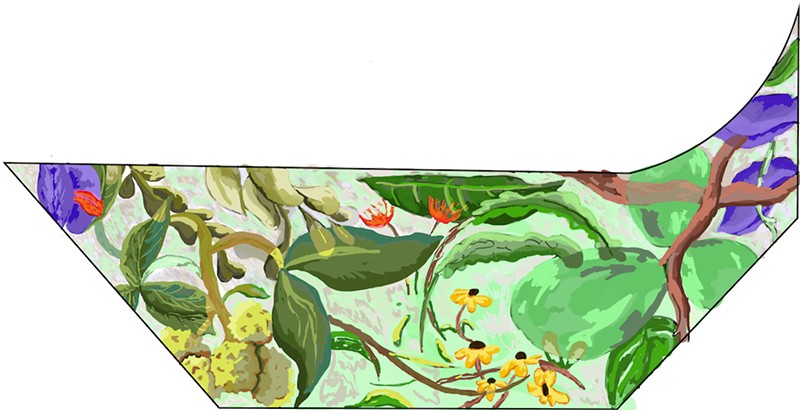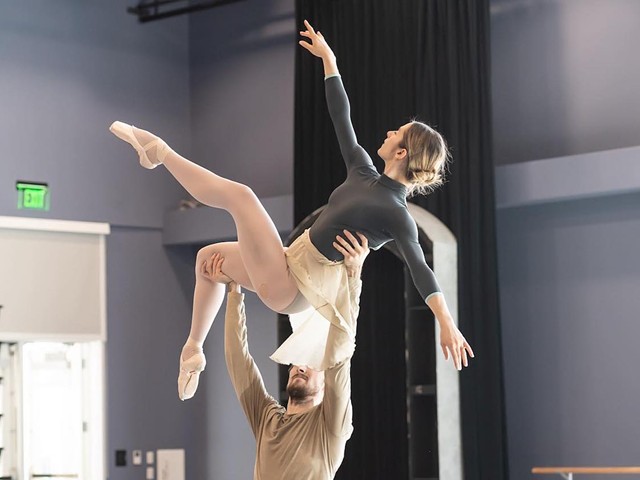This story is featured in CityBeat's May 31 print edition.
Wave Pool is taking art to the streets this summer with the mission to create safer roads through their Art for Pedestrian Safety project. Wave Pool executive director Cal Cullen recalls a handful of occasions that Wave Pool’s building has been crashed into by vehicles in its almost nine-year tenure on the corner of Colerain Avenue and Rachel Street in Camp Washington. Luckily, a traffic-calming solution that aims to slow drivers down and reduce traffic accidents that perfectly aligns with Wave Pool’s mission has gained traction around the country and in Cincinnati: street murals.
“Our medium really is the community,” Cullen tells CityBeat. “It can be any kind of medium so long as we’re focusing on solving community issues.”
The Wave Pool street mural project will extend the curb by using street paddles to contain artwork painted on the street by the corners of the sidewalk. By reducing the space drivers have to take turns, the curb extensions will force drivers to slow down to take the turn. One street mural will sit directly in front of the corner of the intersection of Colerain Avenue and Rachel Street that Wave Pool occupies, and spans 20.5 feet. The other street mural will be on the adjacent corner of the Colerain Avenue and Rachel Street intersection, occupying 24 feet of Colerain Avenue and 25 feet of Rachel Street. The murals will consist of an arrangement of overlapping native plants with pastel greens, yellows and blues.

The City of Cincinnati’s Pedestrian Safety Projects program identifies areas where traffic patterns lead to pedestrian vulnerability and creates solutions to help combat traffic-related deaths. Melissa McVay, manager of the Pedestrian Safety Projects program, says street murals increase traffic safety by grounding vehicle operators in a sense of place through shared public art.
The use of street murals to prevent traffic accidents has proven to be effective around the country in a range of settings. A study by Bloomberg Philanthropies that tested the number of traffic accidents before and after the installation of asphalt art across a range of sites — high-density urban, medium to low-density urban and suburban — found that crash rates dropped 17.3% after street murals were installed. Crashes resulting in injury fell 36.5% and crashes involving vulnerable travelers, like pedestrians, scooter users and cyclists, fell 49.6%.
Anecdotally, McVay says street murals that have been installed around the city have been effective in getting people to slow down. Other street murals in the city, like the one in front of Frederick Douglass Elementary School on Park Avenue in Walnut Hills, are mid-block and intersection street murals.
“We do hear that from residents that they feel like, at least when the murals first go in that, yeah, people do slow down and check it out,” says McVay.
The Wave Pool street mural will be the first curb extension mural in the city, says McVay, combining a tested traffic-slowing method — curb extensions — with artistic elements.
“They (street murals) do slow people down. They do have a purpose, but I think pairing them with curb bump-out paddles will double efforts, really,” Cullen says.
Wave Pool held an open call in April and May of 2023 to community artists, soliciting design idea submissions. Hannah Parrett, an adjunct instructor at the University of Cincinnati’s DAAP School of Art, and Miranda Holmes, an adjunct instructor at the Ohio State University’s Department of Art, teamed up on designs that were selected by a jury of community members and artists assembled by Wave Pool.
Parrett and Holmes’ earthy design features a composition of native plants, lithely arranged in layered patterns that suggest movement and the harmonious relationship of local plant life.
Design criteria for street murals is relatively lax. Artists can take liberties with colors and pictorial representations so long as they don’t include words, universally recognized images and logos, or symbols that could be confused for traffic signals, according to the Paint the Streets guidelines. This gives communities and artists the opportunity to create something that truly reflects the community's aura and values.
By inserting imagery of local plant life in a bustling urban neighborhood, Holmes and Parrett hope to spark passerby’s consciousness and appreciation for surrounding natural wonders. “It kind of stimulates curiosity about what is a native plant even, and how come we don’t see them that often,” says Parrett.
Parrett anticipates the design will wow drivers and passersby, which she imagines will encourage more drivers to slow down and take in the street murals.

Photo: Miranda Holmes and Hannah Parrett
A portion of Miranda Holmes and Hannah Parrett's design. The composition of native plants are arranged in layered patterns that suggest movement.
Wave Pool received funding for this project from a grant from Keep Cincinnati Beautiful as a part of their Safe and Clean program, which accepts applications for projects concerning community safety and livability with neighborhood-level development projects. The Wave Pool street mural project, with its hybrid pedestrian and traffic safety and aesthetic-enhancing outcome, was seen as a great community-building solution by Keep Cincinnati Beautiful grant reviewers, says Ania Cosby, who manages their Safe and Clean grants.
“Art, it can really be tied into safety. When you have areas that are having murals and art projects on the ground and everywhere, you create a sense of community pride and usually people don't want to do crime,” Cosby told CityBeat. Community art, despite not being a definitive solution, can be a good building block for continued improvement of neighborhood safety, says Cosby.
The Wave Pool street murals are scheduled to be painted in June and July. The date in which the murals will be unveiled to the community has yet to be announced. Along with Parrett and Holmes, community volunteers are invited to help in the painting process.
“Being able to work on something this large, this public, the possibility of bringing in other people to help, I think, kind of adds a different kind of power to the image-making,” says Holmes.
Cullens tells CityBeat that Wave Pool currently videotapes the corner of Colerain Avenue and Rachel Street, where the street murals will be located, so they will be able to visually assess whether drivers are slowing down after the murals’ installation. And of course, monitoring the number of accidents that occur at the corner is an easy way for Wave Pool to measure the success of the project.
“The research shows that when we create these places that are unique and interesting, drivers slow down, because I think there's two things happening,” says McVay. “One, you can tell that somebody cares about this place, right? Because somebody has put effort into it, and so it's intriguing. I think the other thing is that it's something new and something different in the street and so drivers by nature kind of slow down.”
To learn more about Wave Pool’s Art for Pedestrian Safety project, visit wavepoolgallery.org.
Subscribe to CityBeat newsletters.
Follow us: Google News | NewsBreak | Reddit | Instagram | Facebook | Twitter







